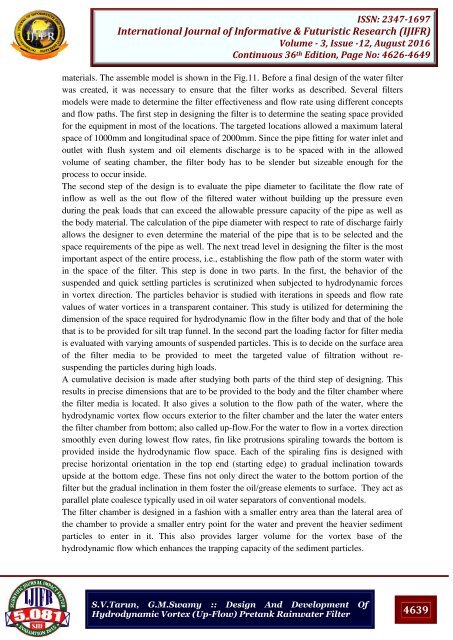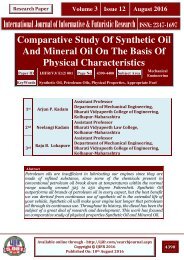IJIFR VOLUME 3 ISSUE 12 AUGUST 2016
RESEARCH PAPER
RESEARCH PAPER
Create successful ePaper yourself
Turn your PDF publications into a flip-book with our unique Google optimized e-Paper software.
ISSN: 2347-1697<br />
International Journal of Informative & Futuristic Research (<strong>IJIFR</strong>)<br />
Volume - 3, Issue -<strong>12</strong>, August <strong>2016</strong><br />
Continuous 36 th Edition, Page No: 4626-4649<br />
materials. The assemble model is shown in the Fig.11. Before a final design of the water filter<br />
was created, it was necessary to ensure that the filter works as described. Several filters<br />
models were made to determine the filter effectiveness and flow rate using different concepts<br />
and flow paths. The first step in designing the filter is to determine the seating space provided<br />
for the equipment in most of the locations. The targeted locations allowed a maximum lateral<br />
space of 1000mm and longitudinal space of 2000mm. Since the pipe fitting for water inlet and<br />
outlet with flush system and oil elements discharge is to be spaced with in the allowed<br />
volume of seating chamber, the filter body has to be slender but sizeable enough for the<br />
process to occur inside.<br />
The second step of the design is to evaluate the pipe diameter to facilitate the flow rate of<br />
inflow as well as the out flow of the filtered water without building up the pressure even<br />
during the peak loads that can exceed the allowable pressure capacity of the pipe as well as<br />
the body material. The calculation of the pipe diameter with respect to rate of discharge fairly<br />
allows the designer to even determine the material of the pipe that is to be selected and the<br />
space requirements of the pipe as well. The next tread level in designing the filter is the most<br />
important aspect of the entire process, i.e., establishing the flow path of the storm water with<br />
in the space of the filter. This step is done in two parts. In the first, the behavior of the<br />
suspended and quick settling particles is scrutinized when subjected to hydrodynamic forces<br />
in vortex direction. The particles behavior is studied with iterations in speeds and flow rate<br />
values of water vortices in a transparent container. This study is utilized for determining the<br />
dimension of the space required for hydrodynamic flow in the filter body and that of the hole<br />
that is to be provided for silt trap funnel. In the second part the loading factor for filter media<br />
is evaluated with varying amounts of suspended particles. This is to decide on the surface area<br />
of the filter media to be provided to meet the targeted value of filtration without resuspending<br />
the particles during high loads.<br />
A cumulative decision is made after studying both parts of the third step of designing. This<br />
results in precise dimensions that are to be provided to the body and the filter chamber where<br />
the filter media is located. It also gives a solution to the flow path of the water, where the<br />
hydrodynamic vortex flow occurs exterior to the filter chamber and the later the water enters<br />
the filter chamber from bottom; also called up-flow.For the water to flow in a vortex direction<br />
smoothly even during lowest flow rates, fin like protrusions spiraling towards the bottom is<br />
provided inside the hydrodynamic flow space. Each of the spiraling fins is designed with<br />
precise horizontal orientation in the top end (starting edge) to gradual inclination towards<br />
upside at the bottom edge. These fins not only direct the water to the bottom portion of the<br />
filter but the gradual inclination in them foster the oil/grease elements to surface. They act as<br />
parallel plate coalesce typically used in oil water separators of conventional models.<br />
The filter chamber is designed in a fashion with a smaller entry area than the lateral area of<br />
the chamber to provide a smaller entry point for the water and prevent the heavier sediment<br />
particles to enter in it. This also provides larger volume for the vortex base of the<br />
hydrodynamic flow which enhances the trapping capacity of the sediment particles.<br />
S.V.Tarun, G.M.Swamy :: Design And Development Of<br />
Hydrodynamic Vortex (Up-Flow) Pretank Rainwater Filter<br />
4639



